-
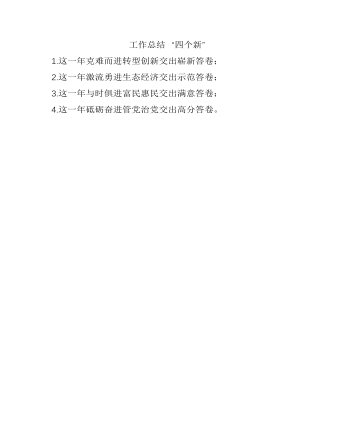
工作总结“四个新”
1.这一年克难而进转型创新交出崭新答卷;
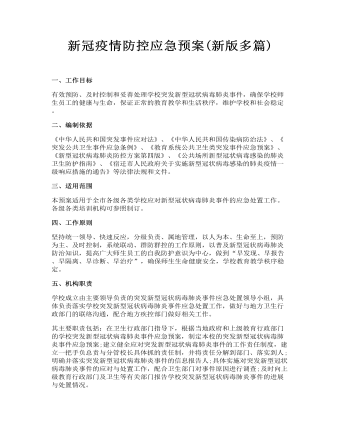
新冠疫情防控应急预案(新版多篇)
四、工作原则坚持统一领导、快速反应,分级负责、属地管理,以人为本、生命至上,预防为主、及时控制,系统联动、群防群控的工作原则,以普及新型冠状病毒肺炎防治知识,提高广大师生员工的自我防护意识为中心,做到“早发现、早报告、早隔离、早诊断、早治疗”,确保师生生命健康安全,学校教育教学秩序稳定。五、机构职责学校成立由主要领导负责的突发新型冠状病毒肺炎事件应急处置领导小组,具体负责落实学校突发新型冠状病毒肺炎事件应急处置工作,做好与地方卫生行政部门的联络沟通,配合地方疾控部门做好相关工作。
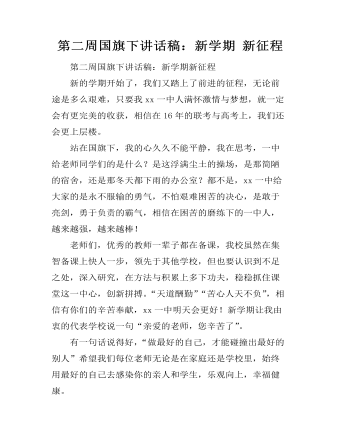
第二周国旗下讲话稿:新学期 新征程
第二周国旗下讲话稿:新学期新征程新的学期开始了,我们又踏上了前进的征程,无论前途是多么艰难,只要我xx一中人满怀激情与梦想,就一定会有更完美的收获,相信在16年的联考与高考上,我们还会更上层楼。站在国旗下,我的心久久不能平静,我在思考,一中给老师同学们的是什么?是这浮满尘土的操场,是那简陋的宿舍,还是那冬天都下雨的办公室?都不是,xx一中给大家的是永不服输的勇气,不怕艰难困苦的决心,是敢于亮剑,勇于负责的霸气,相信在困苦的磨练下的一中人,越来越强,越来越棒!老师们,优秀的教师一辈子都在备课,我校虽然在集智备课上快人一步,领先于其他学校,但也要认识到不足之处,深入研究,在方法与积累上多下功夫,稳稳抓住课堂这一中心,创新拼搏。“天道酬勤”“苦心人天不负”,相信有你们的辛苦奉献,xx一中明天会更好!新学期让我由衷的代表学校说一句“亲爱的老师,您辛苦了”。有一句话说得好,“做最好的自己,才能碰撞出最好的别人”希望我们每位老师无论是在家庭还是学校里,始终用最好的自己去感染你的亲人和学生,乐观向上,幸福健康。
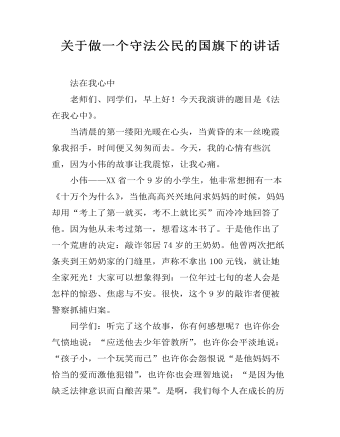
关于做一个守法公民的国旗下的讲话
法在我心中老师们、同学们,早上好!今天我演讲的题目是《法在我心中》。当清晨的第一缕阳光暖在心头,当黄昏的末一丝晚霞象我招手,时间便又匆匆而去。今天,我的心情有些沉重,因为小伟的故事让我震惊,让我心痛。小伟——XX省一个9岁的小学生,他非常想拥有一本《十万个为什么》,当他高高兴兴地问求妈妈的时候,妈妈却用“考上了第一就买,考不上就比买”而冷冷地回答了他。因为他从未考过第一,想看这本书了。于是他作出了一个荒唐的决定:敲诈邻居74岁的王奶奶。他曾两次把纸条夹到王奶奶家的门缝里,声称不拿出100元钱,就让她全家死光!大家可以想象得到:一位年过七旬的老人会是怎样的惊恐、焦虑与不安。很快,这个9岁的敲诈者便被警察抓捕归案。同学们:听完了这个故事,你有何感想呢?也许你会气愤地说:“应送他去少年管教所”,也许你会平淡地说:“孩子小,一个玩笑而已”也许你会怨恨说“是他妈妈不恰当的爱而激他犯错”,也许你也会理智地说:“是因为他缺乏法律意识而自酿苦果”。是啊,我们每个人在成长的历程中都难免会犯错。犯错并不可怕,可怕的是如何面对。
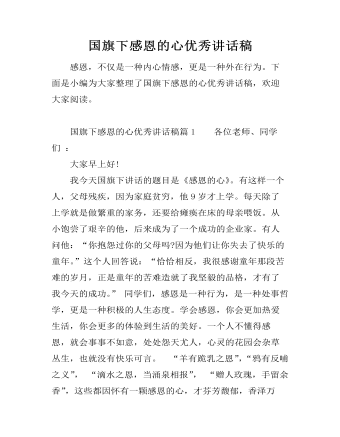
国旗下感恩的心优秀讲话稿
感恩,不仅是一种内心情感,更是一种外在行为。下面是小编为大家整理了国旗下感恩的心优秀讲话稿,欢迎大家阅读。国旗下感恩的心优秀讲话稿篇1 各位老师、同学们 :大家早上好!我今天国旗下讲话的题目是《感恩的心》。有这样一个人,父母残疾,因为家庭贫穷,他9岁才上学。每天除了上学就是做繁重的家务,还要给瘫痪在床的母亲喂饭。从小饱尝了艰辛的他,后来成为了一个成功的企业家。有人问他:“你抱怨过你的父母吗?因为他们让你失去了快乐的童年。”这个人回答说:“恰恰相反,我很感谢童年那段苦难的岁月,正是童年的苦难造就了我坚毅的品格,才有了我今天的成功。” 同学们,感恩是一种行为,是一种处事哲学,更是一种积极的人生态度。学会感恩,你会更加热爱生活,你会更多的体验到生活的美好。一个人不懂得感恩,就会事事不如意,处处怨天尤人,心灵的花园会杂草丛生,也就没有快乐可言。 “羊有跪乳之恩”,“鸦有反哺之义”, “滴水之恩,当涌泉相报”, “赠人玫瑰,手留余香”,这些都因怀有一颗感恩的心,才芬芳馥郁,香泽万里。
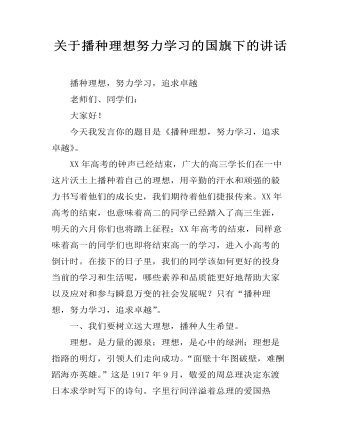
关于播种理想努力学习的国旗下的讲话
播种理想,努力学习,追求卓越老师们、同学们:大家好!今天我发言你的题目是《播种理想,努力学习,追求卓越》。XX年高考的钟声已经结束,广大的高三学长们在一中这片沃土上播种着自己的理想,用辛勤的汗水和顽强的毅力书写着他们的成长史,我们期待着他们捷报传来。XX年高考的结束,也意味着高二的同学已经踏入了高三生涯,明天的六月你们也将踏上征程;XX年高考的结束,同样意味着高一的同学们也即将结束高一的学习,进入小高考的倒计时。在接下的日子里,我们的同学该如何更好的投身当前的学习和生活呢,哪些素养和品质能更好地帮助大家以及应对和参与瞬息万变的社会发展呢?只有“播种理想,努力学习,追求卓越”。一、我们要树立远大理想,播种人生希望。理想,是力量的源泉;理想,是心中的绿洲;理想是指路的明灯,引领人们走向成功。“面壁十年图破壁,难酬蹈海亦英雄。”这是1917年9月,敬爱的周总理决定东渡日本求学时写下的诗句。字里行间洋溢着总理的爱国热情。正是周总理年轻时就能树立如此豪壮的理想,才把苦难的中国人民从水深火热之中拯救出来。
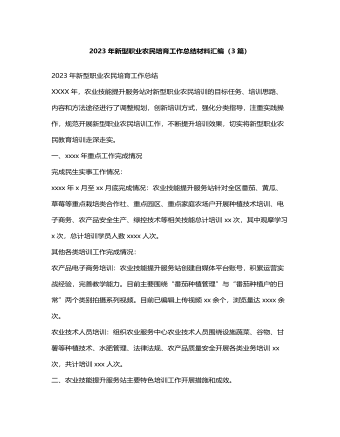
2023年新型职业农民培育工作总结材料汇编3篇
一、基本情况xxxx年我县通过,公开、公平、公正的方法,按照上级文件和《xx县xxxx年全县农民培训工作方案的通知》(x农字(xxxx)xxx号)的要求,遴选了xx县旅游工业中等专业学校为培训工作的第三方,确定了培训对象为家庭农场主、农民合作社带头人、种养大户。按照工作方案要求,已全部完成任务,即经营管理型xxx人,技能服务型xx人,共计培训xxx人。二、项目组织开展情况(一)领导重视。按照省、市文件精神,我县各级领导对高素质农民培育工作非常重视,县成立高素质农民培育工作领导小组。在高素质农民培育过程中,县农业农村局长到实训现场指导培训工作。(二)精准遴选培育对象。根据《xx县xxxx年高素质农民培训工作实施方案》,认真开展了培训对象的遴选。重点面向家庭农场主、农民合作社带头人和种养大户,统筹推进新型农业经营和服务主体能力提升、种养加能手技能培训、农村创新创业者培养、乡村治理及社会事业发展带头人培育等行动,大力培养高素质农民队伍。
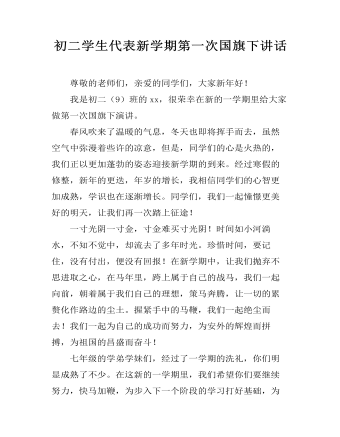
初二学生代表新学期第一次国旗下讲话
尊敬的老师们,亲爱的同学们,大家新年好!我是初二(9)班的xx,很荣幸在新的一学期里给大家做第一次国旗下演讲。春风吹来了温暖的气息,冬天也即将挥手而去,虽然空气中弥漫着些许的凉意,但是,同学们的心是火热的,我们正以更加蓬勃的姿态迎接新学期的到来。经过寒假的修整,新年的更迭,年岁的增长,我相信同学们的心智更加成熟,学识也在逐渐增长。同学们,我们一起憧憬更美好的明天,让我们再一次踏上征途!一寸光阴一寸金,寸金难买寸光阴!时间如小河淌水,不知不觉中,却流去了多年时光。珍惜时间,要记住,没有付出,便没有回报!在新学期中,让我们抛弃不思进取之心,在马年里,跨上属于自己的战马,我们一起向前,朝着属于我们自己的理想,策马奔腾,让一切的累赘化作路边的尘土。握紧手中的马鞭,我们一起绝尘而去!我们一起为自己的成功而努力,为安外的辉煌而拼搏,为祖国的昌盛而奋斗!
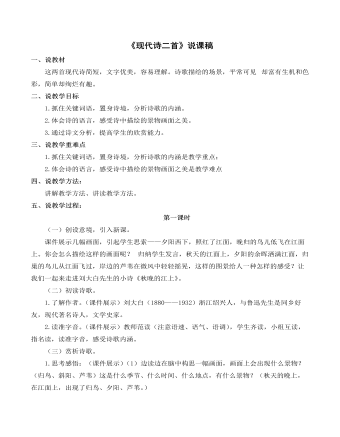
(新)部编人教版四年级上册《现代诗二首》说课稿
(一)创设意境,引入新课。 课件展示几幅画面,引起学生思索——夕阳西下,照红了江面,晚归的鸟儿低飞在江面上。你会怎么描绘这样的画面呢? 归纳学生发言,秋天的江面上,夕阳的余晖洒满江面,归巢的鸟儿从江面飞过,岸边的芦苇在微风中轻轻摇晃,这样的图景给人一种怎样的感受?让我们一起来走进刘大白先生的小诗《秋晚的江上》。(二)初读诗歌。 1.了解作者。(课件展示)刘大白(1880——1932)浙江绍兴人,与鲁迅先生是同乡好友,现代著名诗人,文学史家。 2.读准字音。(课件展示)教师范读(注意语速、语气、语调),学生齐读,小组互读,指名读,读准字音,感受诗歌内涵。(三)赏析诗歌。 1.思考感悟:(课件展示)(1)边读边在脑中构思一幅画面,画面上会出现什么景物?(归鸟、斜阳、芦苇)这是什么季节、什么时间、什么地点,有什么景物?(秋天的晚上,在江面上,出现了归鸟、夕阳、芦苇。)

新人教版高中英语选修1Unit 3 Fascinating Parks教案
2. Explore the significance of the establishment of Sarek National Park.Q1: Which event is the most important one in the park’s history?Ss: The establishment of Sarek national park in 1909 is the most important one.Q2: Is it worth making a place like Sarek a national park? Give your reasons.Ss: Yes. In this way, the place can be kept in its natural state and natural beauties and other rare and valuable resources can be preserved instead of being destroyed by endless exploitation driven by profits.Q3: How does the writer organize his introduction to the history of Sarek?Ss: The writer organizes his introduction in the sequence of time, using time indicators such as “used to”, “around 9,000 years ago”, “soon after”, “following the reindeer”, and “in 1909”.Q4: What is the feature of the language used to introduce the history of the park?Ss: The introduction to the park is to provide facts, using time indicators to organize the events. Sentences starts with “third person” and passive voice is used more often, feeling objective.【设计意图】学生寻找和梳理公园历史上的重要事件,体会人与自然的和谐关系,评鉴介绍性语言的特点。【核心素养提升点】发展自主提取、梳理文本信息能力,训练逻辑思维和高阶思维。Activity 3: Highlighting the secret of the text
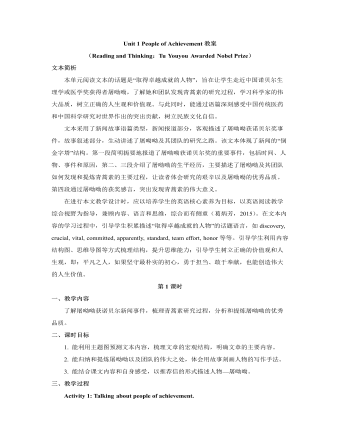
新人教版高中英语选修1Unit 1 People of Achievement教案
【设计意图】 基于上述分析,学生总结新闻故事语篇类型的特征,即标题的省略性、导语的概括性、数据的支撑性和引语的重要性。在此过程中,学生对新闻故事语篇类型有了更深层次的了解,对于学生阅读和写作具有重要意义。Activity 7: Discussing to make a writing outline.本活动为实现课时目标3。1.Discuss and make an outline.Ask students to discuss in groups of four and make their own writing outline.To celebrate the 70th anniversary of the People’s Republic of China, our school newspaper starts a new column about “People of Achievement”. You plan to write a news story about one of the winners of the Medal of the Republic in 2019, including Yu Min, Shen Jilan, Sun Jiadong, Li Yannian, Zhang Fuqing, Yuan Longping, Huang Xuhua and Tu Youyou.【设计意图】 教师创设情境,即为庆祝新中国成立70周年,校报新增有关卓有成就人物的栏目,你将从共和国勋章获得者中,选择一位写一篇新闻故事,向该栏目投稿。学生以小组合作形式,展开讨论,并写出新闻故事框架,有助于学生课后收集人物信息,撰写新闻故事。
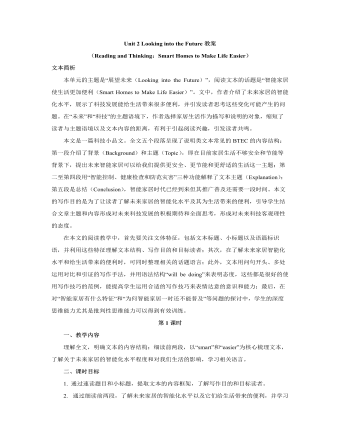
新人教版高中英语选修1Unit 2 Looking into the Future教案
【设计意图】以“新科技是一把双刃剑”为主题开展讨论活动。这个话题比较大,所以给了一定的限制,首先需要以智能家居为例来阐述科技发展对未来生活产生的影响,然后列举其优点和缺点,最后就以上现象发表自己的观点。这个活动是对整个文本的创意性总结与意义的升华,留给学生一定的想象空间,学生借此机会可以运用文本内容和语言表达自己对科技发展的看法和态度。Assignments:1. Finish Exercise 4 on Page 15 of the textbook.A smart home is one that integrated computers into the structure of the building itself. In this way, many of the things that we now do ourselves become automatic. For example, the smart home could control the air conditioning and lights so that you would no longer have to turn switches on and off, and so that your home would be more energy-efficient. The smart home could also monitor itself to make sure that everything is working as it should, and send you warnings if there is a problem. Such smart homes could even be programmed to detect your health problems, and then give you reasonable advice as to the food you should eat or if you should see a doctor. So, in a sense, smart homes will lead us to living smarter lives.2.Create a smart function for your home, and share your creation in the next period.

新人教版高中英语选修1Unit 4 Body Language教案
本阅读材料的话题是交际中的肢体语言,作者从三个方面讲述了肢体语言的特征与作用,通过主题句和举例阐述的方式让读者了解不同文化中肢体语言的相同或者不同的意义,并从更抽象、概括的维度深入认识肢体语言的特点,理解肢体语言的作用。基于肢体语言的特点,作者提醒读者在与人交流中,尤其是当文化背景有差异的时候,要使用得体的肢体语言,尊重、理解和包容不同的文化,进行有效、有素养的沟通。文本共由六个段落组成,篇章结构为“总—分”。第一段用简练的语言引出了话题,并且从我们自身表达的需要和了解他人感受两个角度讲述了肢体语言的作用。第二段阐述了肢体语言的第一个重要特点——肢体语言在不同的文化中有不同的内涵——这也是文中写作篇幅最大的一个要点,最为重要。通过讲述肢体语言的这一特点,作者向读者传递了要尊重不同的文化、要使用与所在文化相宜的肢体语言。
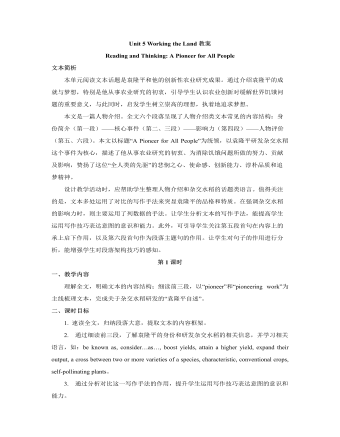
新人教版高中英语选修1Unit 5 Working the Land教案
1. 完成文本主要信息填空(斜体字部分设空):As a witness to farmers’ poor harvests and even a severe shortage of food, Yuan Longping was determined to devote his life to tackling this crisis. After graduation, he realized that what farmers needed most was to boost yields in the fields. Yuan was convinced that the answer lay in the creation of hybrid rice, one characteristic of which is that it usually achieve higher output than conventional crops. However, it was no easy job. The first difficulty he needed to overcome was scientists’ general assumption that this could not be done. Through trial and error, Yuan managed to generate this incredible crop. It is estimated that about 60 percent of domestic rice consumption in China was comprised of crops generated from Yuan’s hybrid strains. His innovation has enabled Chinese farmers to considerably expand their output and helped feed the world. Unwilling to retire early to a life of leisure and unconcerned about celebrity or fortune, Yuan continues to turn one vision after another into realities.2. 模仿写作:Do some research via the Internet and introduce another agricultural scientist, Chen Risheng(陈日胜), using the structure, expressions and writing techniques you have learnt from the text “A Pioneer for All People”.【设计意图】任务1是对文本内容和词汇学习成效的检测。任务2借助文本中学到的词汇和写作手法仿写另一位科学家,提升学生迁移运用词汇、文体结构和写作方法的能力。

新人教版高中英语选修4Unit 1 Science Fiction教案
本活动旨在落实课时教学目标2。 1.Think, discuss and share. Students form groups of 4, discuss about the given ending make comments. Q1: Do you like the ending? Q2: Was it a logical ending? Why so or why not? [设计意图]通过引导学生思考、讨论、评价,比较个人、同伴所预测的结局和听力文本所给定的结局的异同点,深化对文本的认知,发展学生的评判性思维能力。 Activity 4: Exploring Asimov’s three laws of robotics and the purpose of the writing 本活动旨在落实课时教学目标3。 1. Get to know Isaac Asimov’s three laws of robotics. The teacher shares Isaac Asimov’s three laws of robotics. The three laws state that: ①A robot may not injure a human being or, through inaction, allow a human being to come to harm. ②A robot must obey any orders given to it by human beings, except where such orders would conflict with the First Law. ③A robot must protect its own existence as long as such protection does not conflict with the First or Second Law. Q: How does Tony’s story relate to the laws? 2. Figure out Isaac Asimov’s purpose of writing Satisfaction Guaranteed. The students express their opinions about the author’s writing purpose. Q: Why did Isaac Asimov write such a story? S: To explore the relationship between robots and humans. [设计意图]通过了解艾萨克·阿西莫夫所制定的机器人三大定律,加深学生对文本的理解,深入探究文本的主题意义。推理作者的写作目的,联系生活实际,思考人类与机器人的关系。
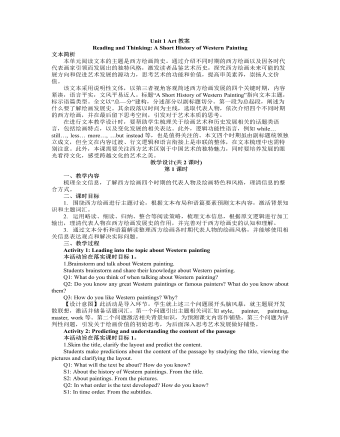
新人教版高中英语选修3Unit 1 Art教案
[2] An important breakthrough…was… [3] Another innovation was … [4] the emphasis increasingly shifted from…to… [5] New ideas and values gradually replaced… [6] While his paintings still had religious themes… … T: All these expressions serve to show how Western painting has developed. Some of them share similar structure but with varied use of words, which makes the text vivid and more readable. 【设计意图】主题类语言整理有助于学生类化语言应用,提高语言输出的丰富性。处理完文本内容信息后,进入语篇信息处理,进行主题相关的词块归类。引导学生快速阅读,寻找表达相同主题(发展或者艺术)的词和短语,再根据词性、用法和结构进行归类,储备主题相关词汇,丰富语言储备,提升语言素养。 Assignment: Go online to gather more information about Chinese painting and write a short history of it. 【设计意图】结合所学,迁移运用,根据实际语境,进行模仿性运用。在此过程中,学生尝试借鉴已学的语言、内容、语篇结构和写作手法来建构新文本,实现语篇输出,同时关注中西艺术文化的差别,加深对优秀文化的认同,培养文化意识。

新人教版高中英语选修3Unit 2 Healthy Lifestyle教案
Activity 4: Figuring out the structure and the writing purpose 本活动为实现课时目标2。 1.Read Paragraph 6 and think about its main idea and the writer’s writing purpose. Q1: If you were the author, how would you end your article? “For young people, there is plenty of time to change bad habits. However, there is no “magic pill” or delete button that will help you; you have to think about your bad habits and decide on some changes. You have the power to build a happy and healthy life full of good habits!” Q2: What is Paragraph 6 mainly about? (Possible answer: to appeal to young people including teenagers to change bad habits and live a happy and healthy life.) 2.Think about the writer’s writing purpose and share opinions. Q1: What is the writing purpose? Work in pairs and figure it out. (Possible answer: On the one hand, the passage is written to help teenagers change their bad habits and live a healthy lifestyle. On the other hand, it provides us with a scientific way to identify and analyse our problems objectively, thus strengthening our resolve to tackle the seemingly common yet tough problems in our lives.) 【设计意图】 步骤1旨在预测和验证文章最后一段主要内容,梳理完整的语篇结构,步骤2旨在思考和讨论作者的写作目的。教师也可根据学生课堂反应情况融入对语篇人称多次转换的思考。
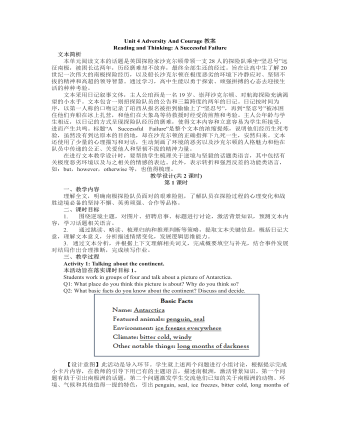
新人教版高中英语选修3Unit 4 Adversity And Courage教案
本活动旨在落实课时目标3。 The Student Union is looking for three students for a 3-week voluntary program in Guizhou province. The volunteers have got to be high school students, with a persevering personality and experiences in overcoming adversity. The volunteers need to stay, eat and teach with 20 pupils in a small school up on the hill of a village. There are no facilities but desks and a blackboard in the school. And there is no take-away food to be bought anywhere; the only way to feed yourself is to cook. You’re interested in applying. Write your application letter introducing what adversity you have ever overcome and how persevering you are as well as what you want to do when at work. Dear Student Union,【设计意图】此任务旨在迁移一、二课时所学,解决实际问题。学生对比自己经历过的挑战或挫折,写信给学生会申请前往贵州担任短期支教教师,把个人以前是怎么战胜挫折的经过书写出来。结合所学,迁移创新,分析解决自身实际问题,在真实情境中学生通过仿写进行主题语言的精确输出。完成任务的过程中,能较多地使用已学语言、内容、结构和写作手法来描述自己面对挫折的处理方式、态度和应有的品质,近一步激发学生树立正确的价值观,学会逆境出人才,坚忍不拔,从容不迫,又做到谦让、分享和合作。课后学生修正习作,再次提交。

新人教版高中英语选修3Unit 5 Poems教案
本单元阅读文本介绍了几种简单的英语诗歌形式,旨在让学生能理解和欣赏英语诗歌的美,包括形式美、内容美、意义美,培养审美情趣,并从作品的意义美中获得积极的人生态度和价值观念启示。 该文本是一则典型的说明性文本,用简单易懂的语言向英语诗歌的初学者们介绍了五种比较简单的英语诗歌形式。文题“A Few Simple Forms of English Poems”是整个文本的核心话题。正文内容共七段,按“总—分—总”建构。第一段为总起段,概述了英语诗歌的创作原因以及主要特点,涉及了形式、内容、意义等方面赏析英语诗歌的几个主要维度;第二段至第六段分别介绍了童谣、清单诗、五行诗、俳句和唐诗五种英语诗歌形式;第七段收尾,鼓励读者尝试英语诗歌创作。 在进行文本教学设计时,要引导学生梳理关于与诗歌要素和诗歌赏析有关的话题类语言,既包括format、rhythm、subject、image等名词,也包括have a strong rhythm、be made up of、contain、consist of、convey这样的动词和动词短语。

新人教版高中英语选修4Unit 2 Iconic Attractions教案
帮助学生通过讨论与对主题的提升,反思自己的旅游方式,以便做出更优化的安排,在今后的旅程中有更多的收益。 Activity 2: Further discussion of the 6 elements above and supplement of more background knowledge 本活动为实现课时教学目标2。 1.Target Q: The writer’s clear target of traveling, meeting the people and experiencing the culture, is closely related to his major in social studies. Then what is social studies? Social studies is a part of a school or college curriculum concerned with the study of social relationships and the functioning of society and usually made up of courses in history, government, economics, civics, sociology, geography, and anthropology. (Dictionary by Merriam-Webster) Reflection: When you go out to travel, what targets do you usually have in mind? 2.Research Q: Suppose you are traveling to Hangzhou during the school holidays, how will you do research on the city? (surf the internet, read books or travel brochures, consult friends, ...) What information will you be interested to know? (location, iconic sites, local cuisines, interesting customs, shopping malls ...) 3.Abandonment To make the most of time, we have to learn to abandon so that we can accomplish our plan. What will you be interested in doing if you go to Hangzhou if you have a week’s time? What if you only have 2 days? 4~5. Venturing & Experiencing Q: What did he venture to do during the trip? What new experiences did he have? In Sydney: attend his first open-air barbecue, enjoy many different but yummy meals In Catherine: observe the life and customs of the aborigines appreciate their music & try the musical instruments: the didgeridoo
